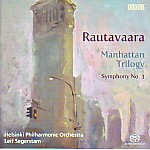As Rautavaara points out in his comments about the Third Symphony (1961), there is no reason why the use of 12-tone technique as musical substructure should be any more evident to the listener than the tonal operations underlying the Bruckner symphonies that inspired this particular work. In both cases, the formal element exists to support the music’s expressive purpose, and recognition of this basic point leaves the composer free to focus on communication rather than composing a piece that does little more than reveal its own structural skeleton. The result, in my opinion, is one of the genuine 20th-century masterpieces in the form. All you need to know to follow the argument is that the opening motive, clearly modeled on the beginning of Bruckner’s Fourth Symphony (with added woodwind arabesques), figures prominently in each of the work’s four movements. As for the rest, you simply sit back and enjoy its four elegantly proportioned and by no means taxingly long parts.
Manhattan Trilogy dates from 2004 and commemorates the composer’s period of study at the Juilliard School in the 1950s (on Sibelius’ recommendation). Its three linked movements–Daydreams, Nightmares, and Dawn–make up an impressionist portrait of a young composer’s hopes and fears. The central nightmares are aptly hallucinatory, but the music is predominantly soft-edged and dreamy, full of those luminous string textures typical of Rautavaara’s late works. It goes without saying that the performances, typical of this series, are absolutely first class. Leif Segerstam and the Helsinki Philharmonic continue to deliver world-beating results with music in which they obviously have a proprietary interest. This is actually the second recording of the Third Symphony for Ondine, and it’s just that much better played and certainly better recorded than its otherwise excellent Leipzig predecessor. Manhattan Trilogy is certainly ravishing, but the Symphony really deserves to enter the repertoire of orchestras the world-over. And if you love Bruckner, even a little, you must hear it. [1/22/2008]
































